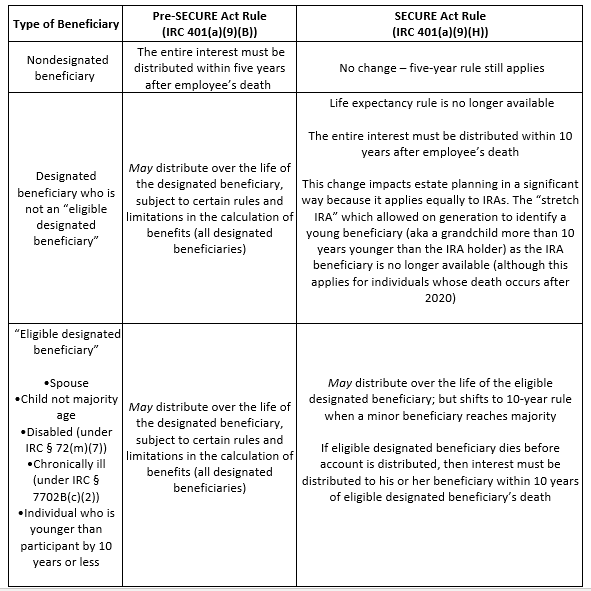
This article originally appeared in Law360 and is republished here with permission.
Hundreds of articles have been published about the Setting Every Community Up for Retirement Enhancement, or SECURE, Act, which was signed into law on Dec. 20, 2019, as part of the late budget bill referred to as the Further Consolidated Appropriations Act for 2020.[1] As you are certainly aware by now, the SECURE Act updates certain retirement-related Internal Revenue Code requirements.
Many of the recent articles focus on some of the big-ticket changes — like the new rules that require employers to permit long-term part-time employees to make deferrals to a 401(k) plan if they satisfy certain requirements over a three-year period. However, many of those rules will not become effective until 2021 and may not have a practical impact on participants until even later.
This article outlines the top three issues we think sponsors of defined contribution plans should be thinking about now.
Key SECURE Act Provisions That May Require Action by Retirement Plan Sponsors in 2020
1. Increases to Permissible Enrollment and Automatic Increase Percentages
- Type of plan: Code Section 401(k)(13) (QACA) safe harbor
- Type of change: Permissible
- Effective date: Jan. 1, 2020
Pre-SECURE Act
Qualified automatic contribution arrangements, or QACAs, are a type of auto-enrollment retirement plan that are also eligible for actual deferral percentage/actual contribution percentage (401(k) plan nondiscrimination testing) safe harbor status under Internal Revenue Code Sections 401(k)(13) and 401(m)(12).
QACA safe harbor designs were introduced under the Pension Protection Act of 2006, effective for plan years beginning on or after Jan. 1, 2008.[2] A QACA provides for default employee elective deferrals (usually pretax, but Roth individual retirement account contributions are permissible), that are uniform for all eligible employees, and that, in the absence of other instructions by the employee, must:
- Begin upon employee eligibility at a minimum of 3% of employee compensation;
- Increase to at least 4% for the second year;
- Increase to at least 5% for the third year; and
- Increase to at least 6% for the fourth and subsequent years.
An auto-escalation feature can increase the default percentage, even above these thresholds, but the maximum default percentage of compensation cannot exceed 10%.[3] Notice requirements apply. Employers must make a minimum matching or nonelective contribution to avoid actual contribution percentage as well as actual deferral percentage testing.[4]
Post-SECURE Act
Effective in 2020, plan sponsors with QACA safe harbor plans can amend their plans to increase the initial and maximum automatic enrollment percentages that apply to new and existing eligible employees. As a reminder, prior to the SECURE Act, QACA plans were:
- Required to automatically enroll participants at a minimum of 3% and incorporate annual automatic increases up to at least 6%; and
- Permitted to automatically enroll participants — initially or as part of an automatic increase feature — to a maximum of 10% of eligible compensation.
The SECURE Act did not change the minimum requirements — so plans can still enroll participants at 3% and increase to 6% — but it did make two important changes to the permissible maximums.
First, the maximum automatic increase percentage is changed from 10% to 15%.
Second, despite the increase to 15%, participants may not be initially automatically enrolled at more than 10% of eligible compensation and, if enrolled at 10%, their enrollment percentage cannot be increased until after the full plan year following the date their first automatic contribution is made to the plan.[5]
Since this change was effective on Jan. 1, plan sponsors with QACAs should consider whether and when to make any changes to plan designs. In making these decisions, remember the following:
The other safe harbor requirements — vesting, employer contributions and uniformity — have not changed. Of these requirements, administration of the uniformity requirement will be the most challenging if a mid-year change is made.
Any mid-year change must satisfy the notice requirements and restrictions set forth in IRS Notice 2016-16.[6]
2. New In-Service Qualified Birth or Adoption Distribution
- Type of plan: 401(a), 403(a), 403(b) and 457(b) government plans
- Type of change: Permissible (we suspect, but the SECURE Act is unclear on its face; it may be mandatory)
- Effective date: Jan. 1, 2020
Pre-SECURE Act
Benefits under defined contribution plans (i.e., the participant’s vested benefit in his or her individual account), particularly in a 401(k) plan, may be paid upon one or more of the following triggering events, depending on the type of plan and plan terms:
- The employee’s death;
- The employee becoming disabled;
- The employee’s separation from employment with the plan sponsor;
- The employee reaching age 59.5;
- The employee experiencing a hardship; or
- The plan’s termination.
Payment earlier than age 59.5 (or before age 55 where a separation from service occurs) attracts a 10% penalty tax on the distributee, unless a different exemption applies. The amount is payable with the individual’s federal income tax return filing.
Post-SECURE Act
Starting Jan. 1, plan sponsors can (and must) amend their plans to permit participants to withdraw up to $5,000 within one year of a qualifying birth or adoption, even if they are not otherwise eligible for an in-service distribution.[7] The following rules will apply to the distributions:
- The 10% early withdrawal penalty will not apply.
- Distribution, which is taxable, will not be treated as an eligible rollover distribution for purposes of the 20% federal withholding (so 10% federal withholding or an election out of withholding is permitted).
- The $5,000 limit is per person, not per family — so spouses participating in the same plan may each take $5,000 — but the limit does apply across all controlled group plans, prohibiting one person in two separate controlled group plans from taking more than $5,000 in the aggregate.
- The distribution can be repaid to the plan or an individual retirement account and the repayment will be treated as nontaxable.
At this point, we advise plan sponsors to note that clients are reporting that employees are actively seeking information about this new distribution right. Therefore, consider whether to incorporate this feature into your plan and, if so, reach out to your service providers to inquire about a reasonable implementation timeline.
Stay tuned, as more guidance is needed in this area, including whether the repayment is a permissible or mandatory provision (e.g., if plans permit the distribution, are they required to permit the repayment?).
3. Administration of New Required Minimum Distribution Rules
- Type of plan: See below
- Type of change: Mandatory, though impact depends on design and administration
- Effective date: See below
Pre-SECURE Act
The required minimum distribution, or RMD, rules have required that living participants in defined contribution plans could, where a plan permits, defer plan distributions until the April 1 after the later of (1) termination of employment or (2) attaining age 70.5.
Defined benefit plans require payments to commence by the later of normal retirement or actual retirement (with an exception for 5% owners). Special rules apply requiring actuarial updates for the accrued benefit of defined benefit plan participants working past age 70.5. Most defined benefit plans commence payment at 70.5 for active employees (instead of providing the actuarial update).
Spousal and nonspousal beneficiaries of deceased participants who had not started receiving required minimum distributions from a retirement plan must commence receiving a death benefit over the beneficiary’s or beneficiaries’ lifetime. Plans may require nonspousal beneficiaries to receive a total distribution within five years of the participant’s death. This usually applies for defined contribution plans, as defined benefit plans don’t always offer a nonspousal death benefit.
Post-SECURE Act
The SECURE Act made two big changes to the RMD rules.
Changes to the manner of distribution when participants die before receiving their entire interest. This change is effective for distributions regarding participants who die on or after Jan. 1, 2020, or who have not attained age 70.5 by Dec. 31, 2019 (some delayed effective dates apply). This change only applies to defined contribution plans.[8] Here’s a snapshot:

If your plan uses the life expectancy rule, then this change will have a practical impact next year (the year following a participant’s death that occurs in 2020). If your plan only uses the five-year rule, then this change will not have a practical impact until 2025.[9]
The most significant RMD change by the SECURE Act increases the age used for purposes of determining the required beginning date for terminated employees, from age 70.5 to age 72.[10] Under this change, distributions to participants who have terminated employment and have not turned 70.5 as of Jan. 1 do not need to commence RMDs until the April 1 following the year they turn 72 (rather than the April 1 after they turn 70.5).[11]
This change applies to all plans subject to the RMD rules under Section 401(a)(9). But, curiously, the provision requiring defined benefit plans to actuarially update the accrued benefit of active participants working past age 70.5 remains at 70.5.[12] The SECURE Act did not adjust this date to age 72. If this is not aligned in subsequent legislation, then this might be one reason that defined benefit plan sponsors are potentially unaffected by the changes.[13]
Action Items
Although these changes will not have an immediate impact on plan administration, we recommend that plan administrators and their counsel discuss whether to adopt these new rules, to the extent the rules are permissive (which is still not entirely clear). The IRS already announced special relief in applying the new RMD rules to individual retirement accounts. Consider how the decision impacts administration and participant communications now. In both cases, we recommend waiting to amend the terms of the plan until the end of 2020, in the hope that additional guidance/model language will be provided later this year.As noted above, the SECURE Act made many other changes that may apply to your retirement plan. Please consult your advisers with questions and stay tuned for additional guidance as it is released.
[1] See Further Consolidated Appropriations Act, 2020 (Pub. Law. No. 116-94, Div. O). [2] Treas. Reg. § 1.401(k)-3(j).
[3] Treas. Reg. § 1.401(k)-3(j)(2).
[4] For more information on QACAs, see Lexis Practice Advisor, 401(k) Safe Harbor Plan Design and Administration.
[5] SECURE Act § 102.
[6] IRS Notice 2016-16, 2016-1 C.B. 318.
[7] SECURE Act § 113.
[8] SECURE Act § 401.
[9] See Lexis Practice Advisor, Required Minimum Distribution Rules under Defined Contribution Plans.
[10] SECURE Act § 114.
[11] I.R.C. § 401(a)(9)(C)(i)(I).
[12] See I.R.C. § 401(a)(9)(C)(iii).
[13] See Lexis Practice Advisor, Suspension of Benefits under ERISA Retirement Plans and Required Minimum Distribution Rules under Defined Benefit Plans.

